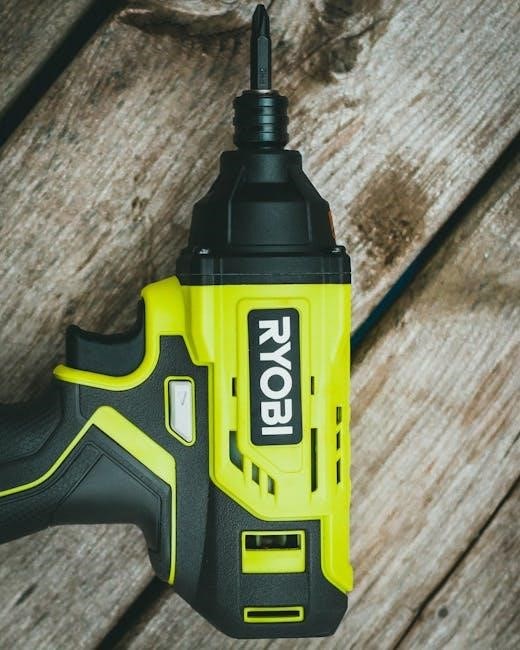Ryobi owner’s manuals provide essential information for understanding‚ assembling‚ and maintaining power tools․ They ensure safe operation‚ proper assembly‚ and effective maintenance․ Available via Ryobi’s official website and third-party sources․
1․1 Importance of Reading the Manual
Reading the Ryobi owner’s manual is crucial for ensuring safe and effective use of power tools․ It provides essential safety precautions‚ assembly instructions‚ and maintenance tips‚ reducing the risk of accidents․ The manual outlines proper operation techniques‚ helping users understand tool features and capabilities․ It also covers troubleshooting common issues‚ saving time and frustration․ By following the manual‚ users can maximize tool performance and longevity․ Additionally‚ it ensures compliance with warranty conditions‚ as improper use may void coverage․ The manual serves as a comprehensive reference guide‚ empowering users to achieve optimal results while maintaining safety standards․
1․2 Overview of Ryobi Product Categories
Ryobi offers a diverse range of power tools and outdoor equipment‚ catering to both professionals and DIY enthusiasts․ Key product categories include cordless drills‚ impact wrenches‚ saws‚ trimmers‚ and pressure washers․ Each category is designed for specific tasks‚ ensuring versatility and efficiency․ For instance‚ Ryobi drills and drivers are known for their high torque and battery life‚ while trimmers and lawn mowers provide reliable solutions for yard maintenance․ The manuals for these products are tailored to their unique features‚ ensuring users can unlock their full potential․ With a focus on innovation and durability‚ Ryobi’s product lineup aims to meet the varying needs of its customers․

Safety Precautions and Guidelines
Safety is a priority in Ryobi manuals‚ providing essential information to prevent accidents․ Instructions include proper tool handling‚ safety symbols‚ and precautions to ensure safe operation and maintenance․
2․1 General Safety Instructions
Ryobi manuals emphasize general safety instructions to ensure safe tool operation․ These include wearing protective gear like safety glasses and gloves‚ avoiding loose clothing‚ and keeping work areas clean․ Users are advised to read the manual thoroughly before use‚ understand all safety symbols‚ and follow guidelines to prevent accidents; Proper tool assembly and maintenance are also stressed to maintain performance and safety․ Adhering to these instructions helps minimize risks and ensures optimal tool functionality․ Always prioritize safety when handling power tools to avoid injuries and equipment damage․
2․2 Safety Symbols and Their Meanings
Ryobi owner’s manuals include safety symbols to convey critical information quickly․ Common symbols include a triangle with an exclamation mark‚ indicating a warning‚ and icons for eye protection or electrical hazards․ These symbols are explained in a dedicated section of the manual‚ ensuring users understand potential risks․ Proper interpretation of these symbols is essential for safe tool operation and compliance with safety guidelines․ Always refer to the manual’s symbol guide to avoid accidents and ensure proper usage․ Understanding these symbols is a key step in maintaining a safe working environment with Ryobi power tools․
2․3 Handling Precautions for Power Tools
Proper handling of Ryobi power tools is crucial for safety and efficiency․ Manuals emphasize wearing protective gear like gloves‚ safety glasses‚ and keeping loose clothing tied back․ Ensure tools are used for their intended purpose‚ avoiding overload or misuse․ Regularly inspect tools for damage‚ such as frayed cords or blunt blades‚ and replace worn parts promptly․ Maintain a firm grip on the tool to prevent loss of control․ Keep children and bystanders at a safe distance․ Additionally‚ avoid using tools in wet conditions or near flammable materials․ Following these precautions minimizes risks and ensures safe‚ effective operation of Ryobi power tools․ Always prioritize caution․

Product-Specific Manuals
Ryobi offers detailed manuals for specific products like trimmers‚ drills‚ saws‚ and pressure washers․ These guides provide assembly‚ usage‚ and maintenance tips tailored to each tool․
3․1 Ryobi Trimmer Manuals
Ryobi trimmer manuals are comprehensive guides designed to help users effectively operate and maintain their trimmers․ These manuals typically include detailed assembly instructions‚ safety precautions‚ and maintenance tips to ensure optimal performance․ Users can find step-by-step instructions for replacing starter ropes‚ adjusting handles‚ and troubleshooting common issues․ Additionally‚ the manuals often cover proper storage and care techniques to extend the tool’s lifespan․ Available in PDF format‚ these manuals can be downloaded from Ryobi’s official website or third-party sources‚ providing easy access to essential information for both new and experienced users․
3․2 Ryobi Drill and Driver Manuals
Ryobi drill and driver manuals offer detailed guidance for users to maximize the performance of their power tools․ These manuals typically include torque settings‚ battery care instructions‚ and proper usage techniques․ They also cover assembly‚ maintenance‚ and troubleshooting common issues like motor overheating or battery charging problems․ Additionally‚ the manuals provide safety precautions and diagrams to ensure safe and efficient operation․ Available in PDF format‚ Ryobi drill and driver manuals can be downloaded from the official Ryobi website or third-party sources‚ making it easy for users to access essential information for their specific models․
3․3 Ryobi Saw Manuals
Ryobi saw manuals are comprehensive guides tailored for various saw models‚ including cordless and corded options․ These manuals provide detailed instructions on blade installation‚ safety measures‚ and optimal cutting techniques․ They also cover maintenance procedures‚ such as lubrication and blade sharpening‚ to extend tool longevity․ Troubleshooting sections address common issues like uneven cuts or motor malfunctions․ Additionally‚ diagrams and illustrations help users understand complex operations․ Available for download on Ryobi’s official website and third-party platforms‚ these manuals ensure users can access vital information to operate their saws safely and effectively‚ maximizing their performance and lifespan․

3․4 Ryobi Pressure Washer Manuals
Ryobi pressure washer manuals offer detailed guidance for setup‚ operation‚ and maintenance․ They cover topics like assembling hoses‚ nozzles‚ and detergent injectors‚ as well as safety precautions to prevent injury․ The manuals provide troubleshooting tips for common issues such as low pressure or pump failure․ Maintenance instructions include filter cleaning and winterization to ensure longevity․ Diagrams and step-by-step instructions help users understand complex procedures․ Available on Ryobi’s official website and third-party sites‚ these manuals are essential for optimal performance and safe operation‚ ensuring users can tackle cleaning tasks effectively while maintaining their equipment properly․

Understanding the Manual Structure
Ryobi manuals feature a clear structure with a table of contents‚ diagrams‚ and step-by-step instructions․ They include troubleshooting sections and safety guidelines for easy navigation and comprehensive guidance․
4․1 Table of Contents and Index
The table of contents in Ryobi owner’s manuals provides a detailed overview of the document structure‚ making it easy to locate specific information quickly․ Each section‚ from safety guidelines to maintenance instructions‚ is clearly listed for seamless navigation․ The index further enhances accessibility by alphabetically organizing key terms and topics‚ allowing users to find relevant sections without browsing through the entire manual․ This organized approach ensures that users can efficiently access the information they need‚ whether they are assembling a new tool or troubleshooting common issues․
Both the table of contents and index are designed to streamline the user experience‚ ensuring that critical information is readily available․ This systematic arrangement helps users make the most of their Ryobi tools by providing clear‚ concise‚ and easily accessible instructions․
4․2 Diagrams and Illustrations
Ryobi owner’s manuals are enriched with detailed diagrams and illustrations to visually guide users through tool assembly‚ operation‚ and maintenance․ These visual aids simplify complex instructions‚ ensuring clarity and understanding․ From exploded views of tool components to step-by-step assembly diagrams‚ users can easily identify parts and procedures․ Safety symbols and torque settings are also illustrated to emphasize critical precautions․ The inclusion of these visuals complements the written instructions‚ making the manual more user-friendly․ Diagrams are particularly useful for troubleshooting and maintenance tasks‚ providing a clear reference for proper tool usage․ This combination of textual and visual information ensures that users can confidently operate and maintain their Ryobi tools effectively;
Diagrams are often accompanied by numbered keys and brief descriptions‚ enhancing their utility for both novice and experienced users․ This visual support is a key feature of Ryobi manuals‚ aiding in the proper and safe use of their power tools; Additionally‚ full-color diagrams are frequently available online‚ offering even greater detail for complex tasks․ By integrating visuals into the manual‚ Ryobi ensures that users can follow instructions accurately‚ reducing the risk of errors and improving overall performance․ This approach underscores Ryobi’s commitment to providing comprehensive and accessible resources for their customers․
4․3 Step-by-Step Instructions
Ryobi owner’s manuals feature detailed step-by-step instructions to guide users through various tasks‚ from assembly and operation to maintenance and troubleshooting․ Each instruction is clear‚ concise‚ and logically structured to ensure ease of understanding․ Whether it’s assembling a new tool or performing routine maintenance‚ the manual breaks down processes into manageable steps‚ reducing confusion and ensuring tasks are completed correctly․ Specific details‚ such as torque settings and safety checks‚ are highlighted to emphasize proper procedures․ This approach helps users avoid common mistakes and ensures tools function optimally․
Step-by-step guides are particularly useful for first-time users or those unfamiliar with power tools․ By following these instructions‚ users can achieve professional results while maintaining safety standards․ The manual also includes troubleshooting sections with sequential steps to diagnose and resolve common issues․ This structured approach ensures that users can address problems efficiently without seeking external assistance․ Overall‚ the step-by-step format enhances the user experience‚ making Ryobi tools more accessible and user-friendly for a wide range of skill levels․

Assembly and Maintenance Instructions
Ryobi manuals provide crucial procedures for assembling and maintaining tools․ They include torque settings‚ lubrication‚ and storage tips‚ ensuring optimal performance and durability of your equipment․
5․1 Assembly Requirements for New Tools
Assembly of new Ryobi tools requires careful attention to manual guidelines to ensure safety and functionality․ Begin by unpacking and inspecting all components for damage․ Use the provided torque specifications to avoid over-tightening‚ which may damage the tool․ Apply recommended lubricants to moving parts for smooth operation․ Follow step-by-step instructions for attaching handles‚ guards‚ or other accessories․ Ensure all safety features‚ such as guards and switches‚ are properly installed․ Double-check connections for batteries or power cords before first use․ Proper assembly ensures optimal performance‚ longevity‚ and safe operation of your Ryobi tool․ Refer to diagrams in the manual for visual guidance․
5․2 Regular Maintenance Procedures
Regular maintenance is crucial for ensuring the longevity and performance of Ryobi tools․ Start by cleaning the tool regularly to remove dirt and debris‚ which can interfere with functionality․ Lubricate moving parts as specified in the manual to reduce friction and wear․ Check for worn or damaged components and replace them promptly․ Store tools in a dry‚ cool place when not in use to prevent rust and corrosion․ Follow the recommended maintenance schedule outlined in the manual for tasks like blade sharpening or battery calibration․ Proper upkeep ensures safety‚ efficiency‚ and extended tool life․ Always refer to the manual for model-specific maintenance instructions․
5․3 Storage Recommendations
Proper storage is essential to maintain the condition and functionality of Ryobi tools․ Store tools in a dry‚ cool place away from direct sunlight and moisture to prevent rust and corrosion․ Use the original case or a protective cover to safeguard against dust and damage․ For cordless tools‚ remove batteries before storage to avoid discharge and degradation․ Avoid extreme temperatures‚ as they can affect battery performance and tool longevity․ Recharge batteries to 50% capacity before storing for extended periods․ Regularly inspect stored tools for signs of wear or damage․ Proper storage ensures tools remain in optimal condition and ready for use when needed․

Troubleshooting Common Issues
Troubleshooting guides in Ryobi manuals help users identify and resolve common faults․ They provide step-by-step solutions for issues like faulty starters‚ carburetor problems‚ and battery malfunctions․
6․1 Identifying Faults and Errors
Identifying faults and errors in Ryobi tools is crucial for effective troubleshooting․ Manuals provide detailed guides to recognize common issues‚ such as faulty starters‚ carburetor problems‚ or battery malfunctions․ Users are advised to look for symptoms like unusual noises‚ reduced performance‚ or error codes․ The manual often includes diagnostic charts or tables to help pinpoint the root cause of the problem․ By understanding these indicators‚ users can address issues promptly‚ preventing further damage․ Regular maintenance‚ as outlined in the manual‚ can also help identify potential faults early․ This section emphasizes the importance of observing tool behavior and consulting the manual for accurate fault identification․
6․2 Resetting Tools and Devices
Resetting Ryobi tools and devices is often necessary after experiencing malfunctions or errors․ The manual provides step-by-step instructions for resetting specific models‚ such as pressure washers or drills․ For many tools‚ resetting involves turning the device off‚ unplugging it‚ and waiting a few minutes before restarting․ Some models may require resetting the circuit breaker or replacing fuses․ If a tool has a safety feature or overload protection‚ the manual will outline how to reset it properly․ Always refer to the specific model’s manual for accurate reset procedures․ Resetting ensures the tool returns to normal operation without causing further damage․
6․3 Common Problems and Solutions
Ryobi tools may encounter common issues such as faulty batteries‚ clogged fuel lines‚ or malfunctioning motors․ For trimmers‚ issues like tangled strings or blocked air filters are frequent․ Pressure washers may experience pump failure or nozzle blockages․ Drills often face chuck or gear problems․ The manual provides troubleshooting steps‚ such as cleaning filters‚ replacing worn parts‚ or resetting tools․ For example‚ resetting a trimmer involves clearing the fuel line and rechecking the spark plug․ Regular maintenance‚ like lubricating moving parts or tightening loose connections‚ prevents many issues․ Always refer to the manual for model-specific solutions to ensure proper repair and avoid further damage․

Downloading and Accessing Manuals
Ryobi manuals are accessible via the official Ryobi website‚ third-party manual databases‚ and mobile apps․ They provide easy access to instructions for various Ryobi tools and devices․
7․1 Official Ryobi Website Resources
The official Ryobi website is the primary source for downloading owner’s manuals․ It offers a user-friendly search function‚ allowing users to find manuals by product category or model number․ Popular categories include grass trimmers‚ lawnmowers‚ and saws․ Manuals are available in PDF format‚ ensuring easy access and readability․ The website also provides additional resources‚ such as FAQs‚ troubleshooting guides‚ and warranty information․ By visiting the official Ryobi site‚ users can ensure they are accessing accurate and up-to-date instructions for their specific tools․ This resource is ideal for those seeking reliable information directly from the manufacturer․
7․2 Third-Party Manual Websites
Third-party websites like ManualsLib‚ Manua․ls‚ and others provide access to Ryobi owner’s manuals․ These platforms offer a wide range of manuals for various Ryobi products‚ including grass trimmers‚ drills‚ and saws․ Users can search by product category or model number‚ making it convenient to find specific guides․ While these sites are helpful‚ it’s important to ensure the manuals are genuine and up-to-date․ Some platforms may host user-contributed content‚ which should be verified for accuracy․ Third-party resources can be useful when official manuals are unavailable‚ but users should exercise caution to avoid outdated or incorrect information․
7․3 Mobile Apps for Manual Access
Several mobile apps offer convenient access to Ryobi owner’s manuals‚ enabling users to view and download instructions on the go․ Apps like the Ryobi Tool Manuals app provide a comprehensive library of manuals for various tools․ Users can search by product model or category‚ ensuring quick access to the needed information․ These apps often feature offline access‚ making them useful in areas with limited internet connectivity․ Additionally‚ some apps include notification updates for new manual releases or revisions․ Mobile apps are a modern‚ eco-friendly alternative to physical manuals‚ offering enhanced portability and ease of use for Ryobi tool owners․

FAQ and Common Questions
The FAQ section addresses common inquiries about Ryobi tools‚ covering troubleshooting tips‚ product registration‚ and warranty information to assist users effectively․
8․1 Warranty and Support Information
Ryobi manuals often include details about product warranties‚ offering insights into coverage periods and conditions․ Users can register their tools on the official Ryobi website to activate warranties․ Support information‚ such as contact details for authorized service centers‚ is also provided․ Additionally‚ the manuals guide users on how to access repair services and troubleshoot common issues․ For further assistance‚ Ryobi’s customer support can be reached via phone or through their online portal․ This ensures users receive timely help and maintains their tools’ performance and longevity․

8․2 Compatibility of Accessories
Ryobi owner’s manuals often detail compatibility information for accessories‚ ensuring users can identify suitable parts for their tools․ This section helps users understand which attachments or components work with specific models‚ preventing mismatches that could compromise performance or safety․ Manuals typically list approved accessories and provide guidelines for installation․ Using genuine Ryobi parts is strongly recommended to maintain warranty validity and ensure optimal functionality․ Compatibility charts or tables may also be included for easy reference․ Always check the manual before purchasing or installing any accessory to avoid potential risks or damage to the tool․ This ensures seamless integration and extends the life of your Ryobi equipment․
8․3 Battery Care and Charging
Battery care and charging are crucial for maintaining the performance and longevity of Ryobi power tools․ Manuals provide detailed guidelines for charging batteries correctly‚ emphasizing the importance of using genuine Ryobi chargers to prevent damage․ Overcharging should be avoided‚ as it can reduce battery life․ Storage recommendations include keeping batteries in a cool‚ dry place away from metal objects to prevent accidental discharge․ Proper maintenance ensures reliable power and extends the lifespan of your Ryobi tools․ Always follow the manual’s instructions for charging and storing batteries to maintain optimal performance and safety․ This helps preserve the overall efficiency of your Ryobi equipment․
Environmental and Disposal Guidelines
This section covers eco-friendly practices for Ryobi tools‚ emphasizing proper disposal of batteries and tools‚ recycling programs‚ and sustainable usage tips for environmental responsibility․
9․1 Proper Disposal of Tools and Batteries
Proper disposal of Ryobi tools and batteries is crucial for environmental safety․ Separate batteries from tools and recycle them through designated programs․ Tools should be disassembled‚ with metal parts recycled․ Follow local regulations for hazardous waste disposal to prevent contamination․ Do not dispose of batteries in regular trash‚ as they contain harmful materials․ Use eco-friendly practices to ensure sustainable waste management․ Always check for nearby recycling centers that accept power tool components․ Proper disposal helps protect the environment and adheres to legal requirements․ Recycle responsibly to minimize the ecological impact of Ryobi products․
9․2 Recycling Options for Ryobi Products
Ryobi offers various recycling options for their products to promote sustainability․ Battery recycling programs are available at authorized service centers and select retailers․ Many communities also provide drop-off locations for electronic waste․ Additionally‚ Ryobi partners with organizations to ensure responsible recycling of power tools and accessories․ Check the official Ryobi website for local recycling centers near you․ Participating in these programs helps reduce environmental impact and conserves valuable resources․ Recycling ensures that materials are repurposed efficiently‚ supporting eco-friendly practices․ Always verify the specific guidelines for recycling Ryobi products in your area to ensure compliance and effectiveness․ Proper recycling contributes to a greener future and aligns with Ryobi’s commitment to environmental responsibility․
9․3 Eco-Friendly Usage Tips
Using Ryobi tools in an eco-friendly manner involves several practical tips․ Always opt for energy-efficient settings and avoid unnecessary power usage․ Regularly maintain tools to ensure optimal performance‚ reducing energy waste․ Use rechargeable batteries responsibly and recycle them through designated programs․ Properly dispose of old tools and accessories via Ryobi’s recycling initiatives; To minimize environmental impact‚ follow the manual’s guidelines for eco-conscious operation․ Additionally‚ consider using biodegradable materials for cleaning and maintenance․ By adopting these practices‚ users can significantly reduce their environmental footprint while extending the lifespan of their Ryobi products․ Eco-friendly usage not only benefits the planet but also aligns with Ryobi’s commitment to sustainability․
Adhering to Ryobi owner’s manual instructions ensures optimal performance and safety․ Regularly update your knowledge with new manuals and guidelines for enhanced productivity and eco-friendly usage practices․
10․1 Importance of Adhering to Manual Instructions
Adhering to Ryobi owner’s manual instructions is crucial for ensuring safety‚ proper tool assembly‚ and effective maintenance․ Manuals provide detailed guidelines to avoid accidents and optimize performance․ By following instructions‚ users can troubleshoot common issues efficiently and maintain their tools’ longevity․ Proper usage also aligns with environmental guidelines‚ promoting eco-friendly practices․ Ignoring manual instructions may lead to malfunction‚ injury‚ or voiding warranties․ Always refer to the manual before operating‚ assembling‚ or storing Ryobi products to ensure compliance with safety standards and manufacturer recommendations․
10․2 Staying Updated with New Manuals
Staying updated with the latest Ryobi owner’s manuals ensures access to the most accurate and comprehensive instructions․ Regular updates often include new safety guidelines‚ improved maintenance tips‚ and troubleshooting solutions․ Users are encouraged to periodically visit Ryobi’s official website or authorized third-party sources to download revised versions․ Additionally‚ registering products online can provide notifications about manual updates․ Staying informed helps in maintaining tool performance and adhering to safety standards․ Updated manuals may also include new features or accessories‚ ensuring users get the most out of their Ryobi tools․ Regular checks for updates are a good practice for optimal functionality and safety․
